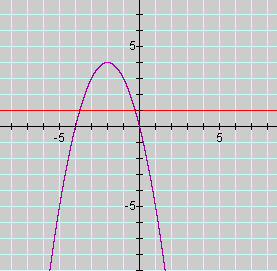
It is a start; incomplete, unclear, maybe in error; maybe glossing over significant points and stressing some obvious or trivial points.
Your assignment:
Sign on as a co-author. Rewrite and complete the article.
This means you must come to grips with whatever points are to
be essential,
what to add, what to delete, and what to edit. The "different"
approaches to this topic are really in the graphs in the xb,
xc, or xa planes.
You might want to examine a bunch of these before trying to re-write.
It has now become a rather standard exercise, with availble technology, to construct graphs to consider the equation
and to overlay several graphs of
for different values of a, b, or c as the other two are held constant. From these graphs discussion of the patterns for the roots of
can be followed. For example, if we set
for b = -3, -2, -1, 0, 1, 2, 3, and overlay the graphs, the following picture is obtained.

We can discuss the "movement"
of a parabola as b is changed. The parabola always passes through
the same point on the y-axis ( the point
(0,1) with this equation). For b < -2 the parabola will intersect
the x-axis in two points with positive x values (i.e. the original
equation will
have two real roots, both positive). For b = -2, the parabola
is tangent to the x-axis and so the original equation has one
real and positive
root at the point of tangency. For -2 < b < 2, the parabola
does not intersect the x-axis -- the original equation has no
real roots. Similarly
for b = 2 the parabola is tangent to the x-axis (one real negative
root) and for b > 2, the parabola intersets the x-axis twice
to show two
negative real roots for each b.
Now consider the locus of the vertices of the set of parabolas graphed from
As you can see from the graph below,
the locus of the vertices of the set of parabolas is itself a
parabola. Upon calculating this value for
each of the graphs pictured below by using the first derivative
of the functions, the vertices are:

All of these points are on the same parabola which is the one that concaves downward. Since the two x-intercepts or the places that satisfy the problem when it equals zero of this parabola are x=1 and x=-1, it is easy to determine the factors of the parabola to be (x-1) and (x+1). In addition, we know that because it has a downward turn that the roots are multiplied by a -1. Therefore, the function of the locus of the vertices of the set of parabolas is:
Graphs in the xb plane.
Consider again the equation
Now graph this relation in the xb plane. We get the following graph.

It is a hyperbola with asymptotes of x = 0 and y = -x.
If we take any particular value
of b, say b = 5, and overlay this equation on the graph we add
a line parallel to the x-axis. If it intersects the curve in the
xb plane the intersection points correspond to the roots of the
original equation for that value of b. We have the following
graph.

For each value of b we select, we
get a horizontal line. It is clear on a single graph that we get
two negative real roots of the original
equation when b > 2, one negative real root when b = 2, no
real roots for -2 < b < 2, One positive real root when b
= -2, and two positive
real roots when b < -2.
Consider the case when c = - 1 rather than + 1.

In this case, we find that the curve
is also a hyperbola with asymptotes again of x=0 and y=-x.
It seems that for any value of b we want where we let b vary,
we can find one negative root and one positive root.
Graphs in the xc plane.
In the following example the equation
is considered. If the equation is
graphed in the xc plane, it is easy to see that the curve will
be a parabola. For each value of c considered,
its graph will be a line crossing the parabola in 0, 1, or 2 points
-- the intersections being at the roots of the orignal equation
at that value of c. In the graph, the graph of c = 1 is shown.
The equation
will have two negative roots -- approximately -0.2 and -4.8.

There is one value of c where the
equation will have only 1 real root -- at c = 6.25. For c >
6.25 the equation will have no real roots and for
c < 6.25 the equation will have two roots, both negative for
0 < c < 6.25, one negative and one 0 when c = 0 and one
negative and one
positive when c < 0.
Send e-mail to jwilson@coe.uga.edu